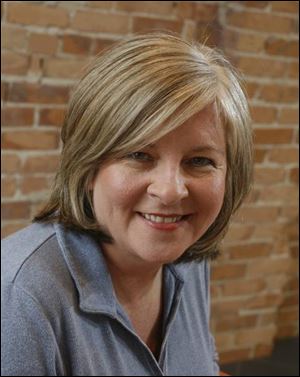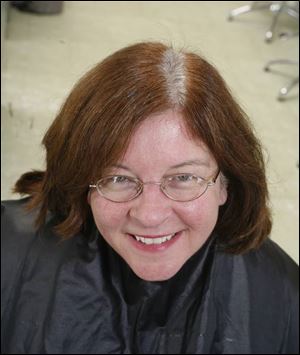
Going gray: Stylists help women make the transition to a new look
10/22/2006
Kathy Luce in a 'before' photo showing gray hair growing out of previously colored hair.

Kathy Luce's new look blends the gray with her old color.
You can go cold turkey to give up cigarettes and desserts. You can resolve to get to church or the gym and just up and do it.
But if your goal is to stop coloring your hair and go gray, you'd better settle in for a process that's going to take awhile.
It'll be worth it, though, promises one woman who is a proud salt-and-pepper.
"I love it. I do," said Carol Leck, 58, of West Toledo. "I have no regrets. I wouldn't go back."
Mrs. Leck stopped having her brown hair colored auburn with copper highlights about 10 years ago when she got tired of the cost and upkeep.
Her stylist suggested applying highlights throughout her hair to blend with the graying new growth, a technique that masks the color line. Today, the silver in her short, graduated bob frames her face at the top and sides, with less salt in the back.
"I get a lot of compliments on it," Mrs. Leck said.
So does Kathy Luce, 50, of West Toledo, who decided earlier this month to stop coloring her hair a medium-to-dark brown that was a sharp contrast to the new growth. "I was having to have it done more and more often," she said.

Kathy Luce in a 'before' photo showing gray hair growing out of previously colored hair.
It took a good four hours for Carmen Wigmans, owner of Reve salon and spa in Sylvania, to apply more than 200 low lights and highlights - white and two dark shades - to blend Dr. Luce's new growth with the old color so the growing-out process can proceed gracefully. "Matching gray hair, to make it look naturally gray, is the most difficult thing to do in hair coloring," Mrs. Wigmans said.
"I love it. When I first looked in the mirror it was a shock," Dr. Luce said, "but the more I look at it, the more I like it, and I've had a lot of compliments."
A slim majority of American women - 54 per cent - color their hair, either at home or in a salon, according to Clairol spokesman Helene Leslie. Speaking from Stamford, Conn., Ms. Leslie said most women who color their hair do so to cover gray, although younger women tend to color more for fun or experimentation.
The more contrast there is between the incoming, graying hair and the artificial color, and the more color-resistant the grays are, the greater the amount of maintenance that's required. Companies such as Clairol have come up with ways to help customers - a root touch-up product to use between full colorings, for example, and another with a pre-treatment that targets grays for better color coverage.
Still, the time, expense, and bother of coloring their hair, at home or in a salon, prompt some women to call it quits.
Sharon Perrotti of Holland said she started going gray in high school. By the time she was 30, her almost-black hair "wasn't gray enough to make it interesting, so I covered it for 10 years. But I wasn't happy with that, either."
The dark artificial color threw off red and bronze highlights. "Then it would fade and it just never looked nice," she said.
Finally, Ms. Perrotti said, one of her bosses asked her, "What are you hiding? Why don't you see what's under there?"
"I let it grow out and I lost 10 pounds," she said, adding, "I couldn't be fat, 40, and gray."
Now 62, she's almost completely white. The transition, which took six months, was achieved via the application of silver highlights and a haircut every three weeks. "It wasn't that bad," she said.
Other women flirt with the idea of going gray, but find they can't go through with it.
"I have a lot of people who talk about it, but sometimes just talking about it will change their mind," said Robin Forst, a board-certified hair colorist and educator at Adagio Day Spa & Color Salon in Maumee. "It's a scary thing to do, because when somebody has been coloring their hair for so long, they're used to that warmth on the face. The gray hair, lacking pigment, is a big change because it doesn't have the warmth."
Mrs. Forst recommends you start by talking to a color specialist so you know what to expect. One way she helps clients visualize how they'd look is to pull back the hair to expose the fringe of gray growing in along the forehead and temples.
A specialist can also tell you how your gray is growing in. "People go gray differently," she explained. "You could be really gray on top of your head and around the hairline, and the back and the nape hardly gray. That's very common."
Many women who start the process turn back because they don't like their graying appearance, Mrs. Forst said.
"I just don't like the way people perceive me when I have the white hair," said Ellen Bishop, 61, of Holland. Twice she has let her hair go silver, then returned to color because "everyone kept assuming I was older than I was."
She noticed it on the job, from men in particular, she said. "I felt like they weren't taking me quite as seriously. I was being treated sort of like a granny," said Ms. Bishop, who's now an ash blonde.
Assumptions go beyond the work site. Ms. Bishop recalled going to see a performance of The Geritol Follies: "I kept hearing people say 'Look at all the white heads' - meaning all the old people - and I think it's this connection that if you have white hair you're old, you think old, and you act old."
But Diann Paulin, 39, of Maumee, said strangers frequently approach her with compliments about her snowy shoulder-length hair. "When I was coloring my hair, that never happened to me," she pointed out.
Mrs. Paulin toughed out the transition without professional help. "I looked like a skunk. I had this big patch of white on top of my head," she said.
Although Mrs. Paulin gets compliments now, she knows that white hair is associated with old age, and works at breaking that link. "Because of my hair color, it forces me to pay attention to my youthfulness in other ways," she said, adding that she's more careful now about her skin and diet.
Mrs. Wigmans, of Reve in Sylvania, said a woman should consider how a change in hair color might affect her image: "Will it make them look more dramatic, or is it just going to age them?"
Hair color "is definitely an accessory, a way to express yourself," Mrs. Wigmans said.
The more white hair a woman has, the prettier it will look when the artificial color is grown out, Mrs. Wigmans said, but the more difficult it will be to do. "The more contrast there is, the harder it is and the longer it takes to achieve a natural look."
How long? Hair grows an average of half an inch a month, or about six inches a year, she said.
Instead of using the slow and steady method of having the new growth blended in and getting frequent haircuts, a client who's in a hurry can opt for the more aggressive technique of a product that removes artificial pigment from the hair, Mrs. Wigmans said. "The downside is sometimes you don't know what tones you'll end up with when the stripper is finished. Sometimes it works well, sometimes not at all."
No matter what route you take to silver, once you get there you should switch to shampoos and conditioners made especially for gray/white hair, which tends to be coarse and prone to yellowing from exposure to sunlight and pollutants such as smoke, the experts say.
Matthew Vincente, owner of the Matthew Vincente Salon in southwest Toledo, recommends shampoos with a violet base to brighten white hair. He also advises clients to use more color on their face to counteract the lack of pigment in their hair, especially if their skin is fair.
Clients who tell him they want to stop coloring and go gray usually say they're tired of the maintenance, worry about "roots," and the expense, he said, adding that, "I always tell them to be prepared for a different look" - one that's aging.
"Some people can look really good, but not many. Some people look harder, or they don't gray evenly," Mr. Vincente said.
The change in hair color also can have an impact on your wardrobe. Ms. Perrotti said she gave away all her beige and brown clothing after she stopped coloring her hair. Now she wears only colors that flatter her white hair, including black, white, blues, true reds, and pinks.
Going gray doesn't mean you can't tinker with artificial color now and then.
Even though Mrs. Leck loves her hair, "every once in awhile I will get low lights in the front. I get real silver near the forehead, so it's just to break it up and match the back."
Contact Ann Weber at: aweber@theblade.com or 419-724-6126.